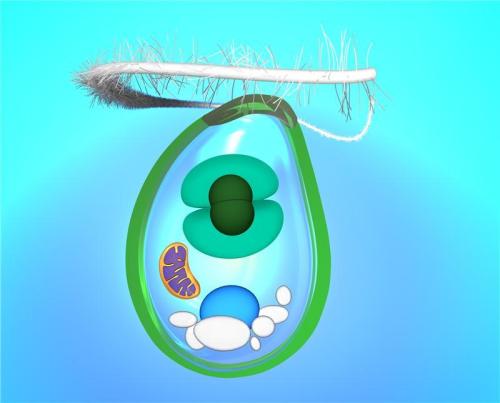Recently, the complete genome of a glaucophyte alga (Cyanophora paradoxa) has been unraveled by an international consortium led by Dr. Debashish Bhattacharya from Rutgers University.
 |
A schematic image of the "living fossil" Cyanophora paradoxa that is a member of the algal phylum Glaucophyta. (Bhattacharya Laboratory) |
<한글기사>
광합성의 기원 밝혀져
오늘날의 지구 생태계를 있게 한 식물의 광합성 작용은 약 16 억년 전 단세포 원생생물이 남조류를 붙잡아 제 몸 안에 간직하면서부터 시작된 것 으로 밝혀졌다고 사이언스 데일리가 27일 보도했다.
미국 러트거스 대학의 진화생물학자 데바시시 바타카리야 교수가 이끄는 국제 연구진은 단세포 조류(藻類) 시아노포라 파라독사(Cyanophora paradoxa)의 게놈 염기 7천만쌍을 해독해 광합성이 어떤 경로를 통해 시작됐는지 밝혀냈다고 사이언스지 최신호에 발표했다.
약 24억년 전 지구 대기층에 `산소 급증 사건'(Great Oxygenation Event)이 일 어났을 때 생물들은 남조류(藍藻類: 엽록소와 남조소를 갖고 있는 세균과 조류 중간 의 단세포 생물)가 광합성으로 만들어내는 독성을 띤 산소를 견뎌내든가 멸종하든가 기로에 서 있었다.
산소는 오늘날 대부분의 생명체를 유지시켜 주지만 GOE 때만 해도 비산소 생명 체들을 대량멸종시킨 독가스였다.
그렇다면 세균과 남조류를 제외한 모든 생물을 가리키는 진핵생물들은 언제 어떻게 햇빛을 붙잡아 산소를 만들어내는 능력을 갖게 된 것일까?
지구 생태계의 진화에서 가장 근원적인 과정 중 하나는 바로 `세포내공생'이라 는 과정을 통해 진핵생물 안에서 광합성이 발달한 것이다.
이번 연구에 따르면 이런 결정적인 진전이 일어난 것은 약 16억년 전 단세포 원 생동물이 이전까지 자유롭게 살던 남조류를 붙잡아 제 몸 안에 간직하면서부터였다.
1차 세포내공생이라고 불리는 이런 과정에서 색소체, 즉 세포내에서 광합성이 일어나는 특정 구역이 탄생했다.
미국 생물학자 린 마걸리스(1938~2011)가 주창한 `세포내공생'설은 세포가 어떻게 복잡성을 갖게 됐는지를 설명해 주는 잘 검증된 가설이다.
세포내공생이란 서로 다른 원핵생물들이 다른 세포의 원형질 안에 살면서 공생 관계를 유지하는 것으로 이 과정에서 진핵생물이 형성됐다는 가설이다.
연구진은 "식물 세계에서 남조류는 동물 세계의 폐어(肺魚)처럼 원시적인 일부 특성을 그대로 간직해 게놈 해독에 이상적인 대상"이라고 설명했다. 학자들은 이 연구가 진핵생물의 광합성 기원을 이해하는 "퍼즐의 마지막 조각"이라고 강조했다.
이들은 단세포 조류 C.파라독사의 게놈 염기서열을 이해하면 식물과 동물의 등장 등 광합성에 이어 진핵생물에 일어난 진화 현상의 대부분을 기본적으로 이해할 수 있을 것이라고 말했다. C.파라독사는 조류와 식물이 공유하는 원시 유전자 다양성의 대부분을 간직하고 있어 연구에 매우 유용한 종이다.
연구진은 "진핵생물의 광합성 설계도가 더욱 명확히 밝혀짐에 따라 앞으로는 모든 조류가 식물의 성질을 갖게 만드는 것이 무엇인지, 더 나아가 각 조류를 구분하는 차이가 무엇인지, 또 이런 기능 뒤에 숨어있는 유전자가 무엇인지 밝힐 수 있을 것이라고 말했다. (연합뉴스)







![[Today’s K-pop] Blackpink’s Jennie, Lisa invited to Coachella as solo acts](http://res.heraldm.com/phpwas/restmb_idxmake.php?idx=644&simg=/content/image/2024/11/21/20241121050099_0.jpg)